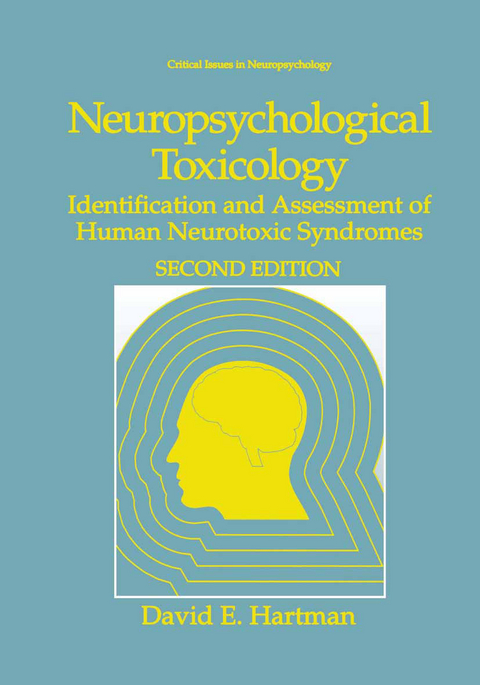
Neuropsychological Toxicology
Kluwer Academic/Plenum Publishers (Verlag)
978-0-306-44922-2 (ISBN)
Greatly revised, the Second Edition presents an extended survey of this rapidly growing field. The book reviews the effects of industrial and pharmaceutical chemicals on human behavior, cognitive function, and emotional status. Features include two new chapters addressing key forensic issues and recent views on multiple chemical sensitivity, sick building syndrome, and psychosomatic disorders; current data on NIOSH and OSHA exposure levels for industrial toxins; and enhanced coverage of testing methods; studies of PET, SPECT, and BEAM imaging applied to neurotoxic exposure.
1 Introduction.- Historical Antecedents of Neuropsychology.- Modern Neurobehavioral Toxicology.- Neuropsychological Testing Strategies.- Historical Views of Neurotoxicity.- Principles of Neurotoxic Damage.- Legislative Issues and Neurotoxic Damage.- Testing Subclinical Neurotoxic Effects.- Advantages of Neuropsychological Toxicology Assessment.- Unsolved Challenges in Assessment of Neurotoxic Syndromes.- Other Issues.- Neuropsychology in Toxic Substance Research.- Who Is at Risk?.- Symptoms of Concern.- Summary.- 2 Evaluation of Neurotoxic Syndromes.- Initial Medical Evaluation.- Health Questionnaire Construction.- Neuropsychological Toxicology Test Battery Construction.- Neuropsychological Toxicology Test Batteries.- Individual Tests.- Children’s Tests.- Interpretation of Neuropsychological Test Results.- Summary.- Testing Cautions.- Complementary Approaches.- 3 Metals.- History.- Variables That Affect Neurotoxicity.- Neuropsychological Testing of Metal Exposure.- Aluminum.- Antimony.- Arsenic.- Barium.- Bismuth.- Cadmium.- Chromium.- Copper.- Gold.- Iron.- Lead.- Lithium.- Manganese.- Mercury.- Nickel.- Platinum.- Selenium.- Silicon and Silicone.- Tellurium.- Thallium.- Tin and Organotins.- Tungsten Carbide.- Vanadium.- Zinc.- Other Metals.- 4 Solvents.- Exposure.- Diagnostic Procedures.- Solvent Mixtures.- Solvent Abuse.- Individual Solvents.- Prognosis for Chronic Solvent Exposure.- Conclusion.- 5 Alcohol.- Acute Effects.- Social Drinking.- Chronic Effects.- Which Tests Show Impairment?.- Recovery of Function.- Isopropyl Alcohol Abuse.- Conclusions.- 6 Drugs.- Prescription Drugs.- Abused and Nonprescription Drugs.- Conclusions—Neuropsychological Toxicology of Drugs.- 7 Pesticides.- Routes of Exposure and Individuals at Risk.- Organophosphates.- Dursban.-Carbamates.- Chlorinated Hydrocarbons.- Chlorinated Cyclodienes.- Other Pesticides.- Fungicides and Fumigants.- Exposure to Combinations of Pesticides.- Herbicides.- 8 Other Neurotoxins.- Acrylamide.- Anesthetic Gases.- Arthrinium.- Aspartame.- Bromine.- Butane.- Carbon Monoxide.- Cassavism.- Chlorine.- Cyanide.- Cycads.- Extremely Low-Frequency Electromagnetic Radiation.- Eosinophilia Myalgia Syndrome.- Ethyl Chloride.- Ethylene Oxide.- Foods.- Food Additives.- Formaldehyde.- Jet Fuels.- Hydrogen Sulfide.- Hyperbaric Nitrogen.- Ionizing Radiation.- Lathyrus sativus (Neurolathyrism).- Ozone.- Pentaborane.- Phenol.- Polychlorinated Biphenyls.- Propane.- Silicon and Silicone.- Toxic Oil Syndrome.- 9 Psychosomatic Disorders.- Multiple Chemical Sensitivity.- Sick Building Syndrome.- Mass Psychogenic Illness.- Workplace Stress.- Posttraumatic Stress Disorder.- Chronic Technological Disaster.- 10 Forensic and Private Practice Issues.- Toxic Torts.- Applying Research Data to Clinical Cases.- References.
| Reihe/Serie | Critical Issues in Neuropsychology |
|---|---|
| Zusatzinfo | XXI, 525 p. |
| Verlagsort | New York |
| Sprache | englisch |
| Maße | 178 x 254 mm |
| Themenwelt | Geisteswissenschaften ► Psychologie ► Biopsychologie / Neurowissenschaften |
| Medizin / Pharmazie ► Medizinische Fachgebiete ► Neurologie | |
| Medizin / Pharmazie ► Medizinische Fachgebiete ► Pharmakologie / Pharmakotherapie | |
| Medizin / Pharmazie ► Pharmazie | |
| Naturwissenschaften ► Biologie ► Humanbiologie | |
| ISBN-10 | 0-306-44922-6 / 0306449226 |
| ISBN-13 | 978-0-306-44922-2 / 9780306449222 |
| Zustand | Neuware |
| Haben Sie eine Frage zum Produkt? |
aus dem Bereich


